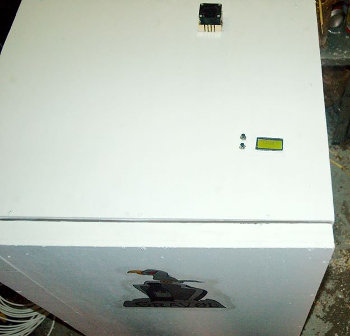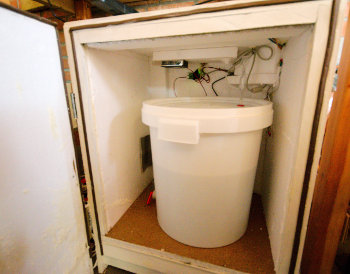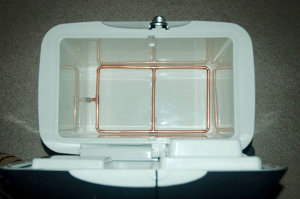My thirst for beer and my thirst for knowledge seem to be converging these months: I'm gaining interest in brewing beer that I don't even particularly like but nonetheless feel compelled to try to brew because it poses a technical challenge. Recently this manifested itself as a desire to brew a lager which requires equipment that I didn't have at the moment.

Lagers ferment at rather low temperatures and home brewers generally solve the problem by converting an electric fridge to maintain stable temperatures slightly above their intended operating range. Some brewers implement this conversion somewhat crudely with a control that turns on and off the mains supply for the fridge; others replace the entire control circuitry with a PID controller of their own.
I was somewhat concerned about the energy consumption of yet another fridge in our home, however, and decided to ally with the cold climate of Scandinavia instead. I realized that the temperature in our unheated garage is largely the same as the outside temperature, and the average fall or spring temperatures are perfect for lager fermentation.
The original lagers were carried into the limestone caves of southern Germany where the temperature remains constant through the changing seasons. My garage is no limestone cave, though, and the temperature certainly isn't constant. This poses an immediate problem because beer requires a correct, constant temperature, not a correct, average temperature. Yeast requires a rather stable temperature for its own health reasons, and it produces different byproducts at different temperatures, rendering the quality of the final beer about as unpredictable as the notoriously volatile Danish weather. Placing the fermentation bucket in the garage during the Danish fall or spring might yield a genuine and decent lager but the result would be neither predictable nor repeatable.
Besides, fridges cool their contents but they don't heat them. The fridge would certainly be capable of keeping the temperature down while the outside was too hot, but the beer would be at the mercy of the elements once the outside temperature dropped below the target. Finally, I'm told that fridges and freezers are manufactured for optimum performance at indoor temperatures. It would seem that a fridge would be happy in cool or cold surroundings but its efficiency would actually drop if moved outside of kitchen temperature surroundings.

I decided to take a different route and construct a climate box from scratch. It was not intended to heat or cool its contents but simply maintain a stable temperature over a few days of varying outside temperatures. In other words, a climate box.
Thinking about it, maybe my real motivation is that the IT business is entirely uninterested in electronics degrees (and, indeed, in any skill beyond entry-level and hence low salary .NET skills, it seems) which in turn is woefully under-stimulated and hence drives me to use my hard-earned university degree for hobby projects instead. At least someone benefits from my efforts this way; I still regret having been involved in surveillance projects tapping into phones in the Middle East.
I constructed the box entirely out of pieces of scrap wood that had been left over after other home projects and was waiting only for my wife or myself to make the next trip to the recycling center. I covered the inside of it with polystyrene and added a wooden floor for the fermentation bucket to stand on. The wooden construction would certainly have been easier with wood that simply needed to be cut into shape rather than being glued together to form sides, but at least this way it was free.

I then purchased an inexpensive 12 V food cooling box in an automobile parts store where it was on sale now that summer was over. I immediately took it apart to salvage the cooler which I knew was a Peltier element. (I turned the box itself into a lauter tun that I have little use for, but that's beyond the scope of this article.)
For heating, I had a spare ceramic heater otherwise intended for our reptilian pets. I suppose I could have build some reversible fan mechanisms and valves to allow the Peltier element to be used for both heating and cooling, but I decided to focus on keeping the climate box insulated.
All that remained was a controller, which again i managed to construct entirely out of components that I already had in my electronics lab. The heart of the controller is an Arduino with a custom shield containing a temperature probe and drivers for the Peltier element and the 230 V ceramic heater.
The Arduino uses separate PID controllers for the cooler and the heater. I decided to leave a grant zone where PID controllers would be turned off to curb their opposed interests somewhat. PID controllers, as we know, are rather aggressive and having two PID controllers combat each other would probably throw the entire universe into a state of chaos before eventually reaching a stable temperature of 21 degrees Celsius which isn't suited for lagers.
You can download the EAGLE schematic and board layout and the Arduino code here: climate-box.zip. The PCB is double-sided but has been designed so that a single-sided PCB is readily possible using just a handful of bridges. Remember to put the voltage regulator and the switching transistor onto heat sinks which should be mounted outside of the climate box for obvious reasons. Or just do as I did: use a regulated power supply, short the voltage regulator, and use a relay instead of the switching transistor. The code is currently modified to be gentle on the relay.
I extended the Arduino's USB to the outside of the climate box which proved useful for tuning the PID controllers. The USB output also allows me to log the temperature development in the climate box.

My first lager beer, which is currently maturing (and "evaporating" at a disconcerting rate because of occasional tasting) in the climate box, will be labeled "Lektor Blommes maltbolche," which is hard to translate as it involves a triple pun. Quite literally, it means "Teacher Blomme's malt candy." The first pun is that "blomme" (the teacher's last name) means "plum" and the beer contains about four kg of beach plums from my garden. The second pun, also on "Blomme," is a reference to my brewery's morbid theme (which will be explained shortly) and requires Danish schooling because any Danish school child has read the book: "Det forsømte forår" ("Stolen Spring") by renowned Danish author Hans Scherfig. One of the prominent characters in the book, the sadistic teacher C. Blomme, is poisoned with a malt candy, and since malt is the major ingredient in beer, this constitutes the third albeit weak pun. The beer label shows the scene where Blomme eats the poisoned candy.
A small Peltier element is rather little for a climate box featuring an entire bucket of fermenting beer, in part because fermenting beer is an exothermic process. The Peltier element seemed capable of counteracting the heat produced by the fermentation, but I had not expected the temperatures to be as high this fall as they turned out to be (everywhere, as it turns out). The climate box couldn't quite keep up with temperatures that were consistently above the target temperature so the beer was fermenting at about 12 degrees Celsius when the temperature should have been about 10 degrees Celsius. It remained mostly stable and within the yeast's preferred range, however, which suffices for my purposes. It seems that global warning may be preventing me from brewing lager except in the coldest winter.
My home brewery is named "Gravøl," which means "Funeral Beer." It has multiple meanings. Firstly, I began brewing while I was trying to recover from a severe depression and the suicidal reference is gallows humor. Secondly, my fondness of hard-core heavy metal prompted me to tip my hat at the morbid universe of the death metal genre. Thirdly, as indicated with a five-pointed star on my brewery logo's beer label, and in concert with a gloomy theme, I firmly believe that the Devil is highly overdue for recognition. With a single exception—a tribute to one of my favorite politicians that he and his party fortunately enjoyed tasting—all of my beer has been named with somber references, the above-mentioned beer being no exception.
Granted, I haven't even attempted to calculate how much energy the climate box saves compared to a fridge, or even if it saves energy at all. But hey, it was home made, and the beer tastes, well, like a lager with a distinct plum flavor.

Leave a comment